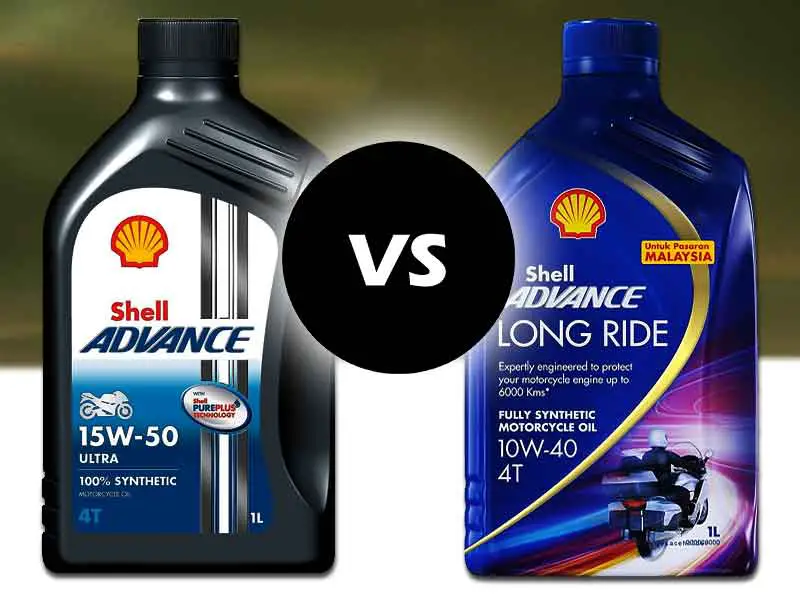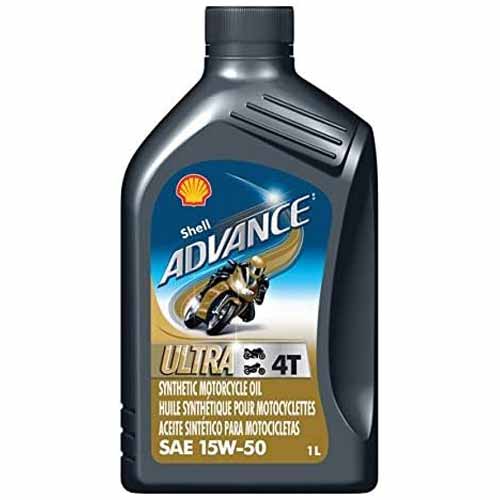Both contenders are manufactured by Shell for modern and high-performance four-stroke motorcycles. Both are suitable for all motorcycles with a wet-type clutch system.
Both of them are manufactured through PurePlus Technology to provide pure and enhanced base oil. They are 100% synthetic and meet the latest API SN and JASO MA2 standards for better performance and efficiency.

Ultra keeps engines clean through its Active Cleansing Technology which enhances its sludge and deposit protection ability.

Ultra is considered to be one of the best engine oils in the industry for its ultimate protection in cold weather conditions and enhance fuel economy.
Long Ride is specially designed to provide some extra mileage to motorcycles for long tours. It can protect an engine for up to 6,000 kilometers. It is also known for its less oil consumption in hot weather due to its strong molecular bonds.
Compared to Ultra, Long Ride provides high mileage and better performance in hot weather conditions, but lacks in cold weather and cleaning ability to its competitor.
Table of Contents
Comparison Table
| Specifications | Advance Ultra | Advance Long Ride |
| Manufacturer | Shell | Shell |
| Oil Type | Full Synthetic | Full Synthetic |
| Available in Viscosity Grades | SAE 10W – 40, 15W – 50, J300 | SAE 10W – 40, 10W – 50, |
| Engine Type | 4-stroke Motorcycle | 4-stroke Motorcycle |
| API Standard | SN | SN |
| JASO Standards | MA2 | MA2 |
| Pour Point, °C | -33 | -30 |
| Flash Point, °C | 230 | 235 |
| Kinematic Viscosity @ 100 °C | 14.2 mm2/s | 19.2 mm2/s |
| Density @ 15 °C | 858 kg/m3 | 867 kg/m3 |
| Cost of 1 liter | 9.44 $ | 9.22 $ |
Features
- Both contenders are made through PurePlus Technology which converts the natural gas into 99 percent pure base oil. This crystal-clear base oil is then being utilized to manufacture both contenders.
- Both contenders are 100 % synthetic made from the base oil mixed with advanced additives to enhance certain properties of them.
- Both competitors are compatible with catalytic converters.
- Ultra is being packed with Active Cleansing Technology which ensures premium engine cleaning from sludge, deposit, and contaminations.
- Ultra also reduces engine vibrations and noises to prolong its lifespan.
- On the other hand, Long Ride enhances the engine’s mileage and keeps it running smoothly for a long journey. Without comprising engines’ performance and protection, it can perform up to 6 KMs.
- Because of having strong molecular bonds, Long Ride ensures minimum oil consumption.
- Long Ride keeps your engine trouble-free due to having high oxidation stability compared to its competitor.
The cleaning ability of Ultra is no doubt phenomenal but Long Ride provides extended mileage, less oil consumption, and a trouble-free engine. So in this regard, Long Ride is superior to its competitor.
Standards
Both competitors meet the latest and most advanced API (American Petroleum Institute) standard SN. The API standardizes the viscosity rating and certain elements for engine oil all over the world to ensure the latest engines’ safety.
API SN is the latest standard that ensures improved sludge control, protection against low-speed pre-ignition (LSPI), enhanced temperature deposit defense for pistons, and improved seal compatibility. This standard is also backward compatible with old engines as well.
Both competitors meet the JASO (Japanese Automotive Standards Organization) standard MA2. The JASO is, an equivalent standard to API, created for the engines manufactured in Japan.
JASO MA is designed for 4 strokes motorcycles with a wet clutch and utilizes one oil system. MA2 is an advanced JASO standard that ensures improved friction performance in the clutch. Also, it is compatible with engine exhaust systems such as catalytic converters.
Fluid Characteristics
Among all the major fluid characteristics, the two important ones are density and kinematic viscosity. Density is the mass of a liquid in a specific amount of volume (1 liter in this case) at a specific temperature.
On the other hand, Kinematic viscosity determines how much a liquid is resistant to flowing, it shows the internal friction of any liquid.
Since the density at 15 °C and Kinematic Viscosity at 100 °C of Long Ride is comparatively higher than its competitor, which means that it would be comparatively heavier and thicker than its opponent respectively.
This would the fuel economy of the engine since more fuel is being utilized by the pump to circulate a relatively heavier and thicker lubricant.
This concludes that Long Ride provides high mileage but at the cost of extra fuel compared to its competitor. So in this regard, Ultra would be a better choice.
Endurance in Extreme Temperatures
Two certain conditions happen when engine oil is in the presence of an extreme temperature environment. It gets evaporated at a high temperature and burns up upon providing an ignition source.
It gets frozen in the cold temperature and loses its ability to flow in the engine to deliver frictionless operation. Both scenarios depend upon two parameters known as the flashpoint and pour point.
The flashpoint determines the maximum temperature at which an engine oil would catch fire upon ignition. And the pour point determines the lowest temperature at which a lubricant would lose its flowing characteristics due to freezing.
Since the flashpoint of Long Ride is relatively higher than its competitor, so it would last longer in a high-temperature environment.
On the other hand, the pour point of Ultra is relatively lower than its competitor which means it would not freeze before its competitor and would last comparatively longer in the cold environment.
So Ultra is a better choice in cold weather while Long Ride should be preferred in hot weather conditions.
Price Comparison
The cost of both competitors isn’t too different from one another. If on one side, Long Ride offers extra mileage, additional features, and protection in hot weather then Ultra also offers better sludge protection, fuel economy, and protection in cold weather.
This would balance the equation and that’s why their prices are almost equal. The cost of 1 liter of Shell Advance Ultra and Long Ride is 9.44 $ and 9.22 $ respectively.
Summary
- Both contenders are designed through PurePlus Technology for 4-stroke motorcycle engines.
- Both of them meet the latest API SN and JASO MA2 standards for better performance and protection.
- Both are fully synthetic and compatible with catalytic converters.
- Ultra provides superior sludge cleaning and deposit protection due to its Active Cleansing Technology.
- Ultra provides better protection in cold temperatures while its competitor should be preferred in high-temperature conditions.
- The density and kinematic viscosity of Ultra is comparatively lower than its competitor.
- Long Ride protects the engines for the long journey which means it delivers extra mileage than its opponent.
- The cost of both contenders is approximately the same.
